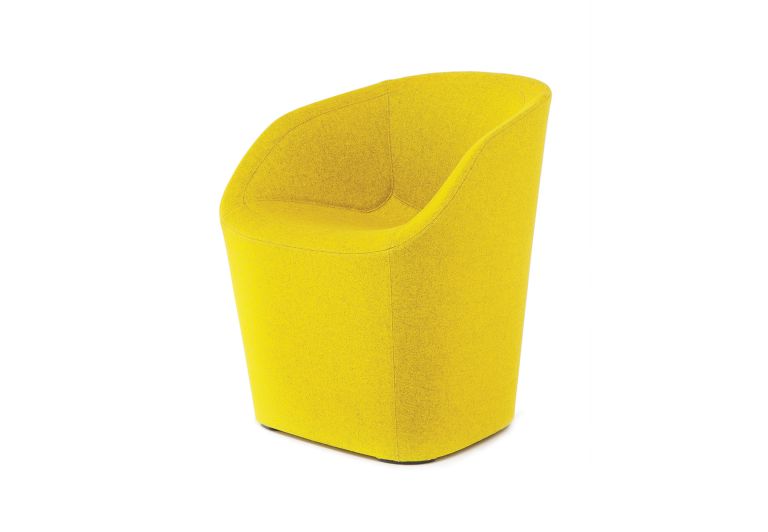Having successfully delivered a number of previous healthcare projects for Melbourne Health, Schiavello was engaged by main contractor, Lend Lease. The broad scope of work at Joan Kirner encompassed general health furniture for main areas, including Krossi Workstations and Kayt Pause Chairs in regular consulting spaces and waiting rooms, with other pieces featured in administrative and back of house areas, as well as the provision of COVID-safe screening options.
For Schiavello’s team, the most complex and rewarding part of this project involved the prototyping and development of specific behavioural health furniture.
Behavioural health describes the connection between behaviours and the health and wellbeing of the body, mind and spirit. This would include how behaviours like eating habits, drinking or exercising impact physical or mental health.
Having worked in healthcare spaces for decades, Schiavello works to continually move alongside the latest research, finding ways to support the healthcare industry through the application of dedicated and responsive design.
A Relationship of Experience and Understanding
Maintaining design integrity and exemplary outcomes throughout a necessarily rigorous approval process requires a high level of trust and expertise.
Schiavello’s team of specialists have broad experience in supporting furniture and design across many of Victoria’s leading hospitals and major health facilities, including the Peter MacCallum Centre, Murdoch Children’s Research Institute, Peter Doherty Medical Research Institute, St. John of God, The Monash Children’s Hospital and the Olivia Newton John Cancer Centre.
“Since we had worked with Western Health before, and on other projects of this scale, Schiavello understood that every solution we offered would need to comply with their specific medical requirements for patients. Approval of anything we discussed or suggested, had to go through the Department of Health.” says Joseph Tigani, National Manager, Schiavello Wellness.
The tailored responses developed for these leading medical institutions has contributed greatly to our team’s collective understanding of the field, each one an invaluable opportunity to further Schiavello’s research and capability in delivering world-class healthcare design.
A Careful Approach To Safe Spaces
“After the client approved the first iteration we put forward, we then got into specific requirements,” says Joseph. “For example – how much does a chair weigh? What type of ligature points are there? There’s a specific checklist we need to tick for furniture in a behavioural health ward; these are things furniture designers and manufacturers don’t normally need to consider so closely outside the realm of healthcare design.
”For safety reasons, these pieces must be either very light – to lessen risk of injury in case a chair is thrown – or so heavy that they can’t be picked up at all by one person alone. In either case, all furniture should have no discernable joins, known as ligature points, to prevent patients taking them apart or finding ways to potentially self-harm.
Together with colleague Rebecca Molland, a former nurse now working with Schiavello in Brisbane, the Wellness team has developed a foam-based furniture system, structurally sturdy and comfortable, yet so light that harm is minimised if used as a projectile. Drawing on the sound experience of healthcare professionals in our network has led to a more meaningful, practical collection overall. The development of safety-first furniture to suit the specific requirements of a mental health was found to be useful to other wards too, such as dementia.
Accustomed to Custom Detail
WIth the extra considerations around optimal furniture weights and safe surfaces at Joan Kirner, Schiavello’s end to end Australian design and manufacturing capability was paramount to meeting the brief. Dining tables, for instance, were upholstered in soft vinyl and internally weighted down with 100 kilos of metal, poured into breather tubes and sealed. Patient beds at Joan Kirner had a similarly stringent design brief – no headboard, no exposed screws or fixings and no ligature points allowed. The team made bed boxes with an entirely seamless finish using high pressure laminate, postformed with a 6mm radius to all edges to prevent injury from sharp edges. Fixed to the floor via metal brackets, the robust base comprises a series of interlocking panels, to brace it against any side or top impact.
Designing with Dignity
Perhaps the greatest success of the Joan Kirner project is reshaping expectations for spaces for behavioural health patients; making them more inviting, and ultimately, more human.
“The client and the Department of Health were pleased with how this project turned out, particularly the aesthetics, since mental health wards can be cold and clinical,” says Joseph. “At Joan Kirner, we’ve introduced much more homely looking furniture in bright colours and added extra little details and elements. These things actually help with their treatment process. It’s a more approachable, comfortable space. It creates the atmosphere of a regular, healthy, social environment.”
Featured Products

Blom Seating










